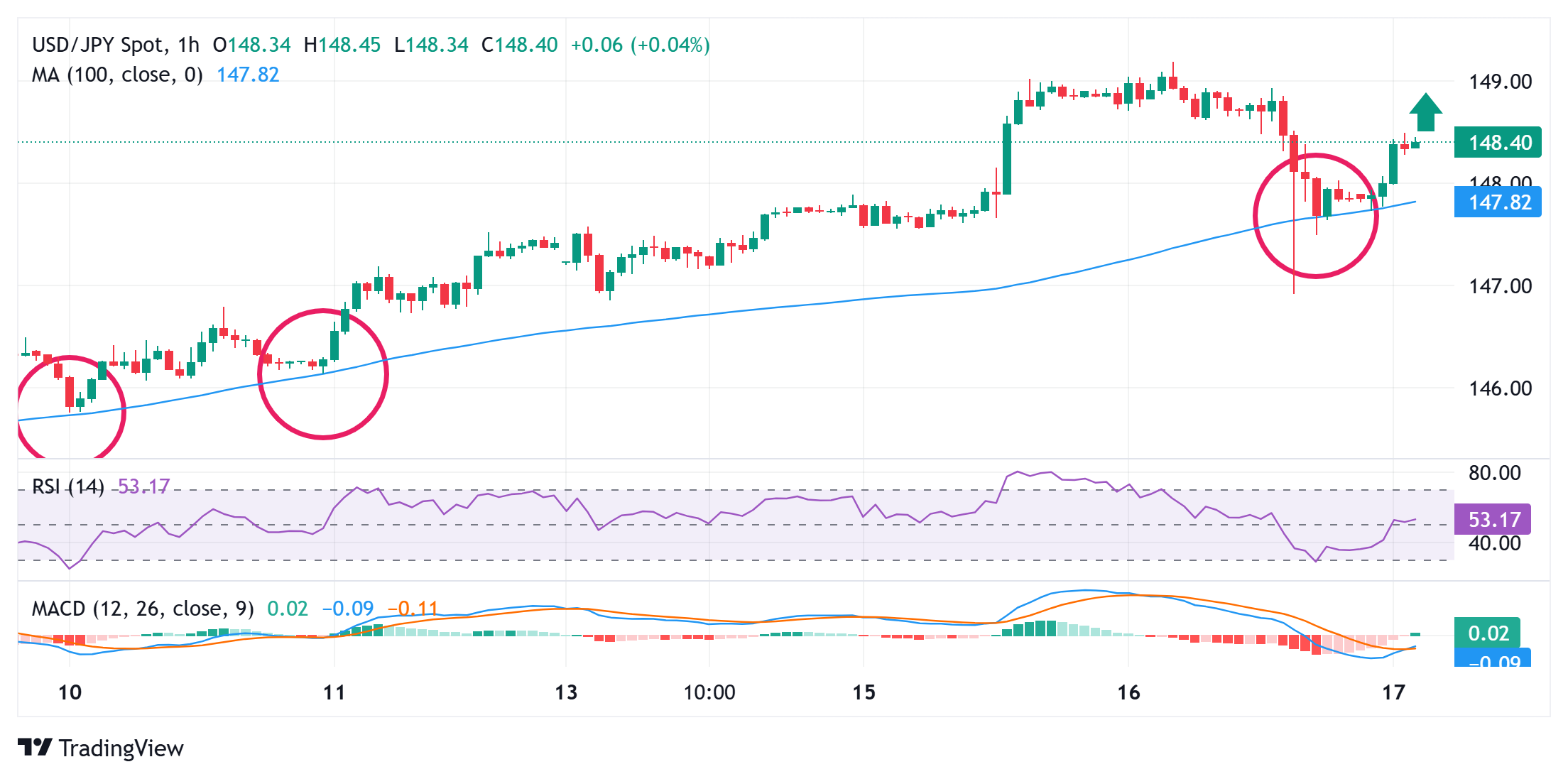Japanese Yen adds to intraday losses amid a broadly stronger USD
- The Japanese Yen meets with a fresh supply in reaction to disappointing Trade Balance data.
- Reduced bets for an immediate BoJ rate hike and a positive risk tone further weigh on the JPY.
- Renewed USD buying further supports the USD/JPY pair and contributes to the move higher.
The Japanese Yen (JPY) extends its steady intraday ascent through the Asian session on Thursday, which, along with a goodish pickup in the US Dollar (USD) demand, lifts the USD/JPY pair above the 148.50 level in the last hour. Data released earlier today showed that Japan clocked a smaller-than-expected trade surplus in June amid a continued decline in exports. Adding to this, slowing economic growth in Japan, declining real wages, signs of cooling inflation, and domestic political uncertainty could complicate the Bank of Japan’s (BoJ) policy normalization path. This, in turn, is seen as a key factor weighing on the JPY.
Meanwhile, most Asian equity markets tracked the overnight positive turnaround on Wall Street that followed US President Donald Trump’s denial of reports that he was close to firing Federal Reserve (Fed) Chairman Jerome Powell. This further seems to undermine the JPY’s safe-haven status. The US Dollar (USD), on the other hand, regains positive traction and reverses Wednesday’s pullback from its highest level since June 23 amid the growing acceptance that the Fed would delay cutting rates. This contributes to the USD/JPY pair’s move up and backs the case for an extension of a well-established short-term uptrend.
Japanese Yen continues to lose ground amid reduced BoJ rate hike bets
- Government data released earlier this Thursday showed that Japan’s trade surplus stood at ¥153.1 billion in June, marking a notable improvement from the ¥638.6 billion deficit seen in the prior month. The reading, however, fell short of expectations for a surplus of ¥353.9 billion as exports fell for the second straight month.
- Japan’s exports declined 0.5% YoY amid sluggish overseas demand, especially in the top market, China, reflecting the sustained impact of US tariffs. Imports, however, improved substantially following a 7.7% fall in May and grew 0.2% YoY vs. expectations for a 1.6% drop, indicating signs of recovery in domestic demand.
- Meanwhile, recent polls indicate that Japan’s ruling coalition – the Liberal Democratic Party (LDP) and Komeito – might lose its majority in the Upper House election on July 20. The outcome could further heighten both fiscal and political risks in Japan and also complicate trade negotiations amid the looming US trade tariffs.
- In fact, US President Donald Trump issued tariff notices to over 20 trading partners, including Japan, which faces a 25% tariff on all exports to America amid stalled US-Japan trade talks. This comes on top of declining real wages and signs of cooling inflation in Japan, which warrants the Bank of Japan’s caution in the near term.
- Investors now seem convinced that the BoJ will forgo raising interest rates this year. Furthermore, traders have been scaling back their expectations for an immediate interest rate cut by the Federal Reserve amid signs that the Trump administration’s increasing import taxes are passing through to consumer prices.
- New York Fed President John Williams warned on Wednesday that the impact of trade tariffs is only just starting to hit the economy. Williams further added that the current modestly restrictive monetary policy is in the right place to allow central bankers to monitor the economy before taking their next steps.
- Separately, Dallas Fed President Lorie Logan said that the US central bank will probably need to leave interest rates for a while longer to ensure inflation stays low. Logan further noted that tariff increases appear likely to create inflationary pressure, and the Fed wants to see low inflation continue to be convinced.
- Trump contradicted media reports that he was planning to oust Fed Chair Jerome Powell and acknowledged that many have said that such a move would disrupt the markets. Trump, however, said that he would love for Powell to resign and unleashed fresh criticism against the Fed chief for keeping rates high.
- Traders now look to the US macro data – monthly Retail Sales figures, the usual Weekly Initial Jobless Claims, and the Philly Fed Manufacturing Index – for some impetus. Furthermore, speeches from influential FOMC members will drive the USD/JPY pair ahead of Japan’s National CPI report on Friday.
USD/JPY bullish technical setup backs the case for a move beyond 149.00

From a technical perspective, the USD/JPY pair showed some resilience below the 100-hour Simple Moving Average (SMA) on Wednesday, and the subsequent move up favors bullish traders. Moreover, oscillators are holding comfortably in positive territory and are still away from being in the overbought zone, suggesting that the path of least resistance for spot prices is to the upside. Hence, some follow-through strength back towards the 149.00 mark, en route to the overnight swing high near the 149.15-149.20 region, looks like a distinct possibility. The upward trajectory could extend further towards reclaiming the 150.00 psychological mark for the first time since late March.
On the flip side, the 148.00 round figure now seems to protect the immediate downside ahead of the Asian session low, around the 147.70 region. The latter nears the 100-hour SMA, below which the USD/JPY pair could retest sub-147.00 levels. Some follow-through selling might shift the bias in favor of bearish trades and drag spot prices to the 146.60 intermediate support en route to the 146.20 area, the 146.00 mark, and the 100-day SMA support, currently pegged near the 145.80 region.




